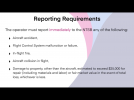That NTSB advisory is very strange. It's dated August 1, 2022, but it repeatedly references the FAA Modernization and Reform Act of 2012 (Public Law 112-95), and specifically sections 333 and 336, which was superseded by the FAA Reauthorization Act of 2018.@Starstuff posted the link above but just for a visual I have attached the NTSB's flowchart. As a 107 operator I would only report to the NTSB when the FAA report is required per 107.9
§ 107.9 Safety event reporting.
No later than 10 calendar days after an operation that meets the criteria of either paragraph (a) or (b) of this section, a remote pilot in command must report to the FAA, in a manner acceptable to the Administrator, any operation of the small unmanned aircraft involving at least:
(a) Serious injury to any person or any loss of consciousness; or
(b) Damage to any property, other than the small unmanned aircraft, unless one of the following conditions is satisfied:
(1) The cost of repair (including materials and labor) does not exceed $500; or
(2) The fair market value of the property does not exceed $500 in the event of total loss.
View attachment 160129
In any case, its interpretation of reportable incidents, including, for example, that if a UAV used under Part 107 loses part of a prop then that must be reported to the NTSB, is simply absurd.
I've emailed the listed contact requesting clarification.












